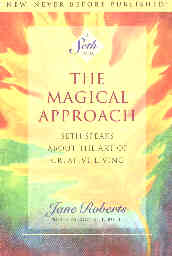New books by deceased authors are rare and when it's by one's favorite author, it's a rare
find. This new Seth book had been on the back burner since Jane Roberts' death in 1984, and was
published finally last year, after her husband had completed several of their other unfinished
projects.
This is the first Jane Roberts book that I have reviewed. I'd finished reading all the other
seventeen of her books before I began starting writing reviews in 1987. The temptation is very great
to try to compress all of my understanding of Jane's works over the years into this first review.
A word about the structure of Jane's books: when she writes a book whose content is
transcribed from Seth sessions, the book says prominently on the cover A Seth Book. This book is
a Seth book. In addition to Seth's words, Seth books are filled with notes written by Robert Butts,
Jane's husband who also takes the session down in shorthand and transcribes them later.
Occasionally he includes some written materials from Jane herself if it is pertinent to the subject.
These notes are invaluable to serious readers of Seth books because they refer to other Seth
sessions and background material concerning Jane and Robert. As the sessions recorded in this
book were taking place, Jane and Robert were finishing up two books, The God of Jane and The
Individual and the Nature of Mass Events. There are several reference to Mass Events in the notes.
In the sessions in this book Seth seems to be talking directly to Jane and Robert, much
more so than in earlier books, as I recall. During the time of the sessions Jane's physical problems
had made it difficult for her to walk more than one or two steps at a time. Seth offers up the
"magical approach" as a means of helping them both to overcome their assembly line approach to
creativity, which approach Seth calls "the mindless repetition of one act after another." That is a
very good definition of what Milan Kundera calls kitsch in the world of art and literature.
Creativity has its own kind of time, a free-flowing time in which past, present, and future
co-exist like in a dream where we can "rummage through the days of the future to find precisely
the data required to make a specific point." Seth contrasts this magical approach with the rational
approach which says "that to solve a problem you worry about it."
The magical approach is a creative approach to life, but Seth stresses that it is not fiction,
but rather a means of "dealing with a larger version of fact from which the world of fact emerges."
Seth cautions that one who sidesteps the "scientific hardbed reality" runs the risk of being
labeled "irrational, fanatic, mad." On page 15 Seth says:
The thin, cold "irrationality" that is recognized as such is instead a fake
veneer covering a far deeper spontaneous rationality, and it is the existence of
that magical rationality that provides the basis for the intellect to begin with.
The rationality that you accept is then but one small clue as to the spontaneous
inner rationality that is a part of each natural person.
Through dreams and synchronistic events Seth is able to show that the rational world view,
far from being a "bulwark of safety" is rather a "barrier to the full use of the intellect, and of the
intuitions". In one dream Robert Butts dreams that a neighbor's dog Gus walked easily through the
solid glass of the storm door to get the food he had for him. Robert leaned down and put his own
arms through the magically diaphanous glass to pet the dog. This is reminiscent of earlier Seth
sessions in which he talks about the fluid nature of the physical world held together by our beliefs.
In Illusions Richard Bach, who wrote his major works after several personal sessions with Seth,
has his hero swimming in solid ground that had turned fluid when he changed his belief about
what was possible.
In another powerful analogy Seth compares the individual's reasoning mind to a coercive
government. When the government reduces the freedom of expression of its people, the oppressed
people may revolt. When the rational beliefs of an individual restricts the freedom of the body, the
body cells will revolt. One can see that the presence of riots and social unrest on a cultural scale is
analogous to accidents and disease on an individual scale. In each case the strictures of the
reasoning mind are overcome and what seemed impossible hours or days before becomes a natural
consequence of the recovery from the unrest.
In my counseling I will sometimes ask two questions of someone who has had an accident
or an illness: 1) What happened as a result that would not have happened otherwise? and 2) What
would have happened if it had not been for the accident/illness? The first question is about
"permission", i. e., what did the accident/illness give you permission to do that your rational mind
would not have given you otherwise? The second question is about "protection", i. e., what did the
accident/illness keep you from doing that may have been even more dangerous or limiting to your
life?
Here are two simple examples from the cultural and individual scales. The government
pulls out of a disastrous war because of the large number of public protests and unrest. The individual
gets much needed bed rest because of a bout with the flu. In both cases a healing takes place in a
way that the rational powers in control had previously discounted as impossible.
This is a great book to begin one's introduction to Seth. Undoubtedly Seth's suggestions
will raise more questions than he answers, but if you find his magical approach suggestive of
better ways of coping with your life, you will be led to rummage through Seth's other books to
satisfy even your rational mind as to the validity of The Magical Approach.
~^~
Any questions about this review, Contact: Bobby Matherne
~~~~~~~~~~~~~~~~~~~~~~~~~~~~~~~~~~~~~~~~~~~~~~~~~~~~~~~~~~

 == == == == == == == == == == == == == == == ==
== == == == == == == == == == == == == == == ==
22+ Million Good Readers have Liked Us
22,454,155
as of November 7, 2019
Mo-to-Date Daily Ave 5,528
Readers
For Monthly DIGESTWORLD Email Reminder:
Subscribe! You'll Like Us, Too!
== == == == == == == == == == == == == == == ==
Click Left Photo for List of All ARJ2 Reviews Click Right Bookcover for Next Review in List
Did you Enjoy this Webpage?
Subscribe to the Good Mountain Press Digest: Click Here!


CLICK ON FLAGS TO OPEN OUR FIRST-AID KIT.
All the tools you need for a simple Speed Trace IN ONE PLACE. Do you feel like you're swimming against a strong current in your life? Are you fearful? Are you seeing red? Very angry? Anxious? Feel down or upset by everyday occurrences? Plagued by chronic discomforts like migraine headaches? Have seasickness on cruises? Have butterflies when you get up to speak? Learn to use this simple 21st Century memory technique. Remove these unwanted physical body states, and even more, without surgery, drugs, or psychotherapy, and best of all: without charge to you.
Simply CLICK AND OPEN the
FIRST-AID KIT.

Counselor? Visit the Counselor's Corner for Suggestions on Incorporating Doyletics in Your Work.

All material on this webpage Copyright 2019 by Bobby Matherne





